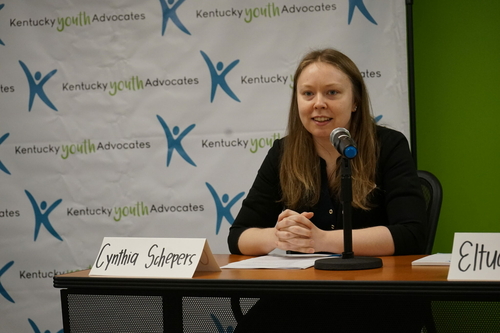Residential foster care in Kentucky is physically, mentally unsafe, say some who have been there

One young adult remembers taking a daily allergy pill upon entering a Kentucky residential foster care facility and leaving “on 13 medications within six months.”
Another lost the privilege of calling their mother after a riot at their location.
These were among the experiences 46 young adults shared with Kentucky Youth Advocates’ researchers, who examined the state’s foster care system and compiled their findings in a Nov. 30 paper titled “Residential Foster Care Analysis Report.”
Other testimonials included reports of overuse of physical restraints when it came to deescalation; fear of safety from fellow residents; significant weight loss or gain from medications, physical activity, nutrition and staff using certain foods as rewards or lack thereof as punishment, resulting in unhealthy relationships with food; and much more.

Youth also reported not feeling like staff could protect them from harm by fellow residents armed with homemade weapons. One participant described their time in residential care as “enduring abuse with no escape.”
“As someone who aged out of the foster care system, I know how important it is to feel heard and understood,” report co-author Cynthia Schepers, peer coach coordinator with Kentucky Youth Advocates and True Up Kentucky, said in a statement. “While we all have different experiences, both good and bad, there is a common theme for foster care alumni — the feeling of not being informed and not feeling listened to.”
There were a few positive reports. Some participants reported “healing and transformative experiences, where they learned coping skills that they still use today” while in the system. Staff who effectively de-escalated with kids “would make the difference for a youth,” the report adds.
Read the paper at this link: https://kya.wpenginepowered.com/wp-content/uploads/2022/11/Residential-Foster-Care-Analysis-Report.pdf
“I restrain kids for a living.”
In addition to the testimonials of youth, researchers also spoke with eight staff and service providers, who said they lacked sufficient staffing capacity and funding for more stimulating activities with youth. Also, insufficient emphasis on work-life balance resulted in mental health strain for staff.
Staff also reported being “under-paid, under-appreciated” and lacking the chance to advance in their careers.
“One staff member recalled consistent nightmares” because of what went on at their workplace and “felt like perhaps working there was unethical,” the report states.
Regarding physically restraining youth, one staff participant told researchers: “Once it was over, I would realize, ‘oh my gosh, I restrain kids for a living.’”
Another suggested it “shouldn’t be legal” at all to put kids in residential facilities.
Racial Disparity
In 2020, the report states, more than 8,000 Kentucky youth were placed in foster care, with about 10% of those going to group homes or institutions.
Racial disparity also emerged in the report.
The percentage of white children in foster care in 2020 — 73% — was less than the state population rate of 74% white. However, the percentage of Black children in foster care was higher than the population rate, 12% to 9%, respectively.
Black children, the report states, are also more likely to have multiple placements, experience group homes, and have “poor social, behavioral and education outcomes.” Additionally, they are less likely to be reunited with birth families and be in a permanent placement.
Calls for change
The report outlines 22 key recommendations to improve the youth care landscape in Kentucky.
“Throughout the research process, we overwhelmingly heard calls for changes needed within residential care facilities, from those who have been residents to those who have cared for those young people,” said study co-author Eltuan Dawson, who is a member of the True Up Peer Network.
Those recommendations include:
- Require training for residential and other non-clinical facility staff in Mental Health First Aid, including common symptoms and appropriate responses.
- Extend access to healthcare coverage beyond age 26 for young people who have residential or institutional placements due to dependency, neglect or abuse.
- Review and study the current Medicaid reimbursement rates provided for needed services to ensure children have access to high-quality services provided by high-quality staff.
- Post a copy of the Foster Youth Bill of Rights in a visible area in every residential facility.
- Ensure youth have access to activities that increase socialization with peers and family members or trusted adults.
“The child welfare system faces undeniable crises that will not be reversed without continued fundamental reform,” Terry Brooks, executive director of Kentucky Youth Advocates, said. “There are unprecedented challenges of childhood trauma, including exploding community needs ranging from the opioid epidemic to deep poverty, to a workforce supply and retention dysfunction that threatens the system, as well as case tragedies that rip apart the heart.”
Brooks added: “Leaders in every branch of government — from front line social workers to legislators to judges to candidates for governor — simply must listen to the voices that this report represents. These courageous young people share their firsthand experience in institutional foster care settings, giving us answers that can be as transformative as they are practical.”








